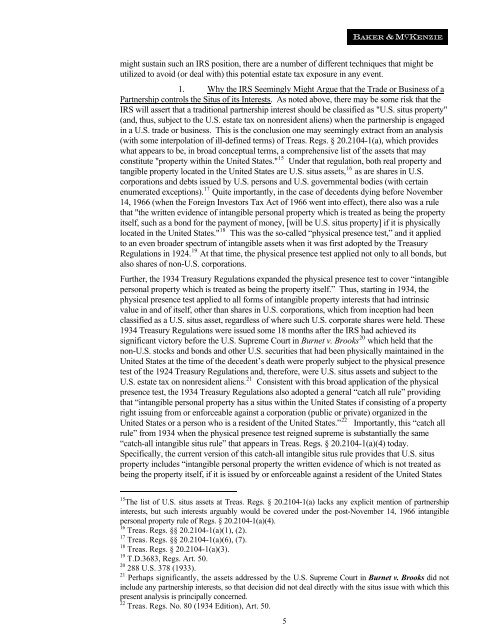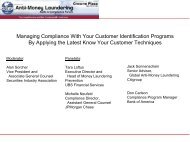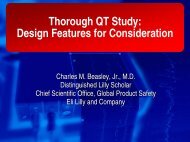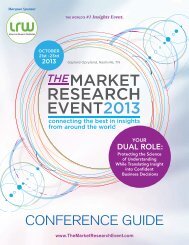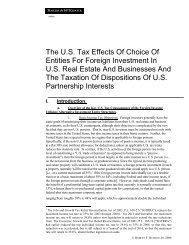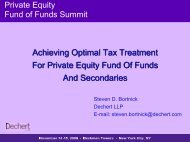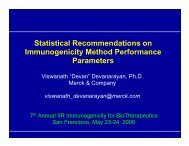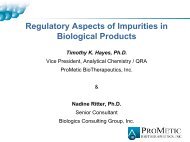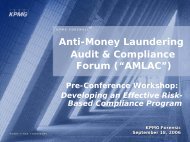The US Tax Effects Of Choice Of Entities For Foreign Investment - IIR
The US Tax Effects Of Choice Of Entities For Foreign Investment - IIR
The US Tax Effects Of Choice Of Entities For Foreign Investment - IIR
Create successful ePaper yourself
Turn your PDF publications into a flip-book with our unique Google optimized e-Paper software.
might sustain such an IRS position, there are a number of different techniques that might be<br />
utilized to avoid (or deal with) this potential estate tax exposure in any event.<br />
1. Why the IRS Seemingly Might Argue that the Trade or Business of a<br />
Partnership controls the Situs of its Interests. As noted above, there may be some risk that the<br />
IRS will assert that a traditional partnership interest should be classified as "U.S. situs property"<br />
(and, thus, subject to the U.S. estate tax on nonresident aliens) when the partnership is engaged<br />
in a U.S. trade or business. This is the conclusion one may seemingly extract from an analysis<br />
(with some interpolation of ill-defined terms) of Treas. Regs. § 20.2104-1(a), which provides<br />
what appears to be, in broad conceptual terms, a comprehensive list of the assets that may<br />
constitute "property within the United States." 15 Under that regulation, both real property and<br />
tangible property located in the United States are U.S. situs assets, 16 as are shares in U.S.<br />
corporations and debts issued by U.S. persons and U.S. governmental bodies (with certain<br />
enumerated exceptions). 17 Quite importantly, in the case of decedents dying before November<br />
14, 1966 (when the <strong>For</strong>eign Investors <strong>Tax</strong> Act of 1966 went into effect), there also was a rule<br />
that "the written evidence of intangible personal property which is treated as being the property<br />
itself, such as a bond for the payment of money, [will be U.S. situs property] if it is physically<br />
located in the United States." 18 This was the so-called “physical presence test,” and it applied<br />
to an even broader spectrum of intangible assets when it was first adopted by the Treasury<br />
Regulations in 1924. 19 At that time, the physical presence test applied not only to all bonds, but<br />
also shares of non-U.S. corporations.<br />
Further, the 1934 Treasury Regulations expanded the physical presence test to cover “intangible<br />
personal property which is treated as being the property itself.” Thus, starting in 1934, the<br />
physical presence test applied to all forms of intangible property interests that had intrinsic<br />
value in and of itself, other than shares in U.S. corporations, which from inception had been<br />
classified as a U.S. situs asset, regardless of where such U.S. corporate shares were held. <strong>The</strong>se<br />
1934 Treasury Regulations were issued some 18 months after the IRS had achieved its<br />
significant victory before the U.S. Supreme Court in Burnet v. Brooks 20 which held that the<br />
non-U.S. stocks and bonds and other U.S. securities that had been physically maintained in the<br />
United States at the time of the decedent’s death were properly subject to the physical presence<br />
test of the 1924 Treasury Regulations and, therefore, were U.S. situs assets and subject to the<br />
U.S. estate tax on nonresident aliens. 21 Consistent with this broad application of the physical<br />
presence test, the 1934 Treasury Regulations also adopted a general “catch all rule” providing<br />
that “intangible personal property has a situs within the United States if consisting of a property<br />
right issuing from or enforceable against a corporation (public or private) organized in the<br />
United States or a person who is a resident of the United States.” 22 Importantly, this “catch all<br />
rule” from 1934 when the physical presence test reigned supreme is substantially the same<br />
“catch-all intangible situs rule” that appears in Treas. Regs. § 20.2104-1(a)(4) today.<br />
Specifically, the current version of this catch-all intangible situs rule provides that U.S. situs<br />
property includes “intangible personal property the written evidence of which is not treated as<br />
being the property itself, if it is issued by or enforceable against a resident of the United States<br />
15 <strong>The</strong> list of U.S. situs assets at Treas. Regs. § 20.2104-1(a) lacks any explicit mention of partnership<br />
interests, but such interests arguably would be covered under the post-November 14, 1966 intangible<br />
personal property rule of Regs. § 20.2104-1(a)(4).<br />
16 Treas. Regs. §§ 20.2104-1(a)(1), (2).<br />
17 Treas. Regs. §§ 20.2104-1(a)(6), (7).<br />
18 Treas. Regs. § 20.2104-1(a)(3).<br />
19 T.D.3683, Regs. Art. 50.<br />
20 288 U.S. 378 (1933).<br />
21 Perhaps significantly, the assets addressed by the U.S. Supreme Court in Burnet v. Brooks did not<br />
include any partnership interests, so that decision did not deal directly with the situs issue with which this<br />
present analysis is principally concerned.<br />
22 Treas. Regs. No. 80 (1934 Edition), Art. 50.<br />
5


